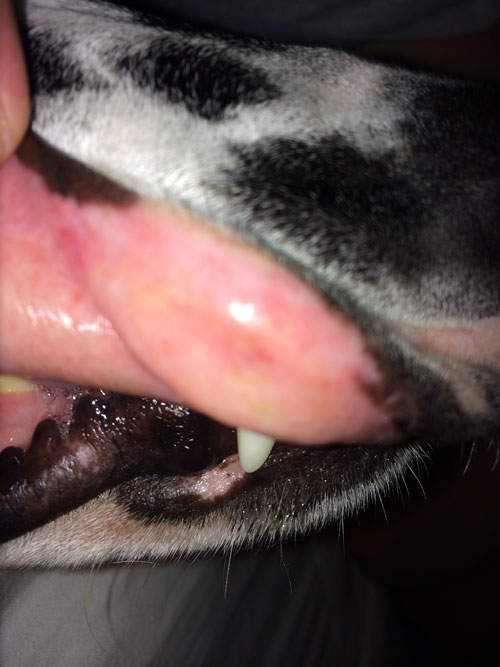- Second Chance AIHA ›
- Forums ›
- AIHA Dog ›
- Hope in a panic
Hope,
Dunes had staph. She was reduced in amount of pred. She had a topical sray and recovered from it. I was freaked.
Joe!
did it look like the pics I uploaded?

Where was it? For some reason none of the 3 vets who looked at it thought of staph but I am going to get them to swab it tomorrow anyway — they all think it’s some kind of trauma, lip chewing, etc.
I was absolutely freaked out Saturday night.. Still am by it’s swelling and going down cycle.
Thanks!
hope
Hope,
Well, I admit being surprised by the information I found. This may be pretty odd but pass this by your vet tomorrow. Merck Manuals are valid and authoritative.
Chronic Ulcerative Stomatitis
Chronic ulcerative stomatitis involves inflammation of the mucous membranes of the mouth. Signs include severe gum inflammation, receding gums in several sites, and large sores on the mouth surface near the surfaces of large teeth. The problem commonly affects Greyhounds, but it has also been seen in Maltese, Miniature Schnauzers, Labrador Retrievers, and other breeds. The characteristic feature is the contact ulcer or sore that develops where the lip contacts the tooth surface, most commonly on the inner surface of the upper lip next to the upper canine teeth. These abnormalities have also been termed “kissing ulcers” because they are found where the lips “kiss” the teeth.
The cause of this disease is an immune system dysfunction that results in an excessive inflammatory response to dental plaque. For this reason, thorough plaque control through professional cleaning and excellent home oral hygiene (including tooth brushing) may resolve the problem. Supplemental antibacterial measures, such as topical chlorhexidine rinses or gels, may be prescribed by your veterinarian. In severe cases, topical anti-inflammatory preparations may provide comfort. Discomfort caused by the ulcers can make it difficult to brush your pet’s teeth and give oral medications. If discomfort is severe and you are unable to brush the teeth, extraction of the adjacent teeth may be necessary to remove the contact surfaces on which plaque accumulates. Although extraction may aid in control of the sores, it may not completely cure the problem, as plaque grows on all surfaces in the mouth and animals can continue to develop sores.
I wouldn’t get terribly upset by this right now. There are plenty of chlorhexidine products on the market, stuff you can add to drinking water, chews, wiping pads etc. Once you talk with your vet you can probably get some samples at the vet’s office to see if it helps any.
my best
patrice
Patrice!
you are wonderful! I printed it out — ready to ask for a swab and mention staph and this.
I saw that mouth ulcers can also be a sign of kidney disease but is that unlikely given they are perfectly symmetrical bumps? I also read on one site that those caused by kidney problems are usually on tongue, cheek or gums (not lip) but I just thought I would ask.
Thanks so much!
hope
Hope, so glad you’re getting such good help with this and Steve is being seen by the specialist. This group is the best. Thinking of y’all and sending love and hugs —
tamara and ashki xoxoxo
Hey all!
took Steve in to see his specialist today — he feels that it is trauma/abrasions (maybe from chewing on a nylabone? I speculate but those things are rough!) and nothing to be concerned about. He also took a swab as well as blood bc I specifically requested a liver and kidney panel. How long do those generally take to come back? He said he would call with results.
Pcv is holding at 40%!! Yay!! It’s been that for 2 weeks now — is it okay that it isn’t going up?
Thanks all for your help and support over the last month… Today is the 1month anniversary of Steve’s diagnosis! Can’t believe it but so thankful for all of you.
hope, Steve and Jeffrey

















































































































































































































































































































